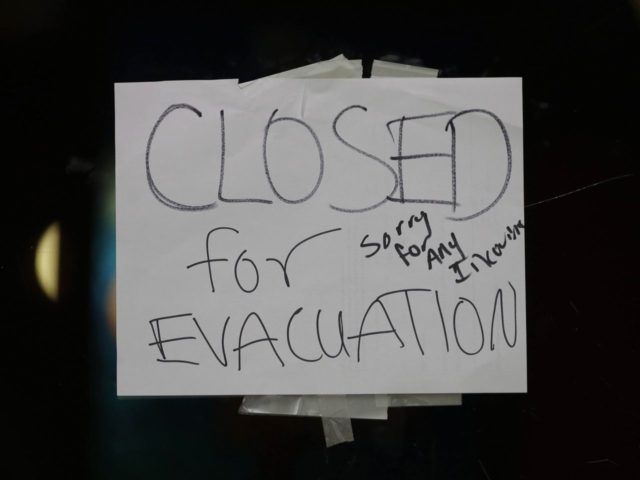The Oroville Dam crisis temporarily subsided Sunday night, as 188,000 residents downriver were evacuated, but the crisis will return with northern California expecting seven straight days of warm rain from another Pineapple Express beginning Wednesday evening.
The water level in Oroville Lake topped the 901 foot crest by up to 4 inches beginning Saturday, sending 500,000 cubic feet per second (cfs) of water over the earthen dam’s mile-long emergency spillway, which had never been activated since the dam, America’s tallest, went into operations in 1968.
Over the next 24 hours, erosion tore a gash in the center of the emergency spillway, threatening a collapse of the spillway. At 5:20 p.m. Pacific Time on Sunday, an emergency evacuation was ordered for 12,000 residents in the City of Marysville and another 35,000 in Butte County. The order spread to 65,000 from Yuba County City and another 76,000 from Yuba County as officials warned that portions of the unstable embankment might collapse.
According to Paul Preston of Agenda 21 Radio, who has been reporting live on scene, the a level of panic was spreading on Saturday afternoon that a 60-foot-high section of the mile-wide emergency spillway was in danger of a general collapse, which would unleash a 10-foot-high wall of water and threaten the safety of up to one million residents downstream.
Breitbart News reported on February 9 that with water flowing into Oroville Lake at the rate of 83,000 cubic feet per second (cfs), officials opened the cement-gated primary spillway to release water at the rate of 35,000 cfs. But the flow surged to 55,000 cfs as a hole roughly 250 feet long, 170 feet wide and 50 feet deep hole opened up in the spillway, sending massive amounts of water and chunks of concrete surging down the Feather River.
Engineers from the California Department of Water Resources (DWR) and collaborating agencies announced they were able to slow water surging down the primary spillway to 20,000 cfs.
But with the 3,537,577-acre-foot reservoir filled to 101 percent of capacity, officials assured the public that water would flow evenly over an emergency spillway on the south facing side of the dam.
Law enforcement sources told Preston the National Guard out of Redding was being mobilized for a disaster deployment.
The crisis situation has temporarily faded with the primary spillway jettisoning water at a rate of over 100,000 cfs, bringing the lake height down to the point at which water has ceased overflowing the emergency spillway. Helicopters have been deployed to drop huge boulders into the crack in the emergency spillway, and clear skies are expected over the next three days.
But beginning on Wednesday evening, another moisture-laden “Pineapple Express” storm system will arrive to hammer northern California’s lower elevations with 7 straight days of rain, while the Sierras expect 11 straight days of rain and snow beginning on Thursday.
With the heaviest snowfall in 22 years, the Sierra snow pack is at 150 percent of its 100-year average. And with temperatures climbing to a high of 49 degrees in Tahoe on Wednesday, 4 degrees above average, snowmelt is expected to be heavier than usual.
Preston reports that the general consensus from the emergency response teams is that the situation will remain stable into Friday. But with accumulating rain and snowmelt causing another overflow of the weakened emergency spillway by late Friday, there is a significant risk of heavy damage to the Oroville Dam spillways.

COMMENTS
Please let us know if you're having issues with commenting.